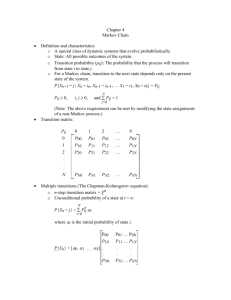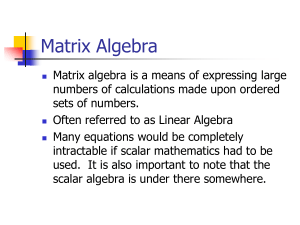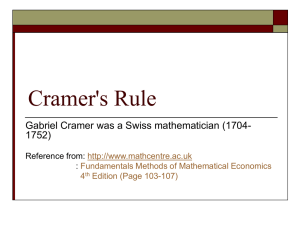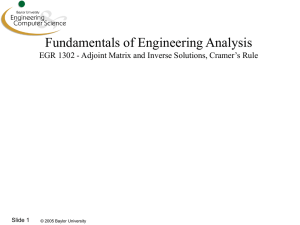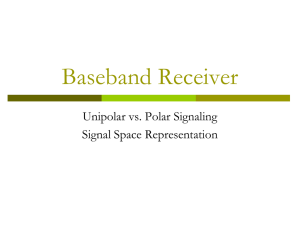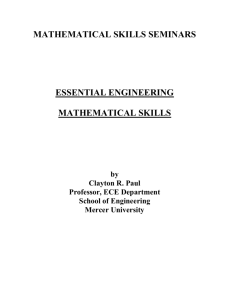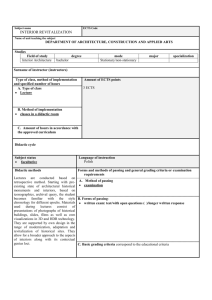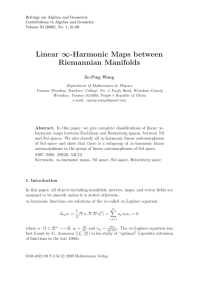September 7
advertisement
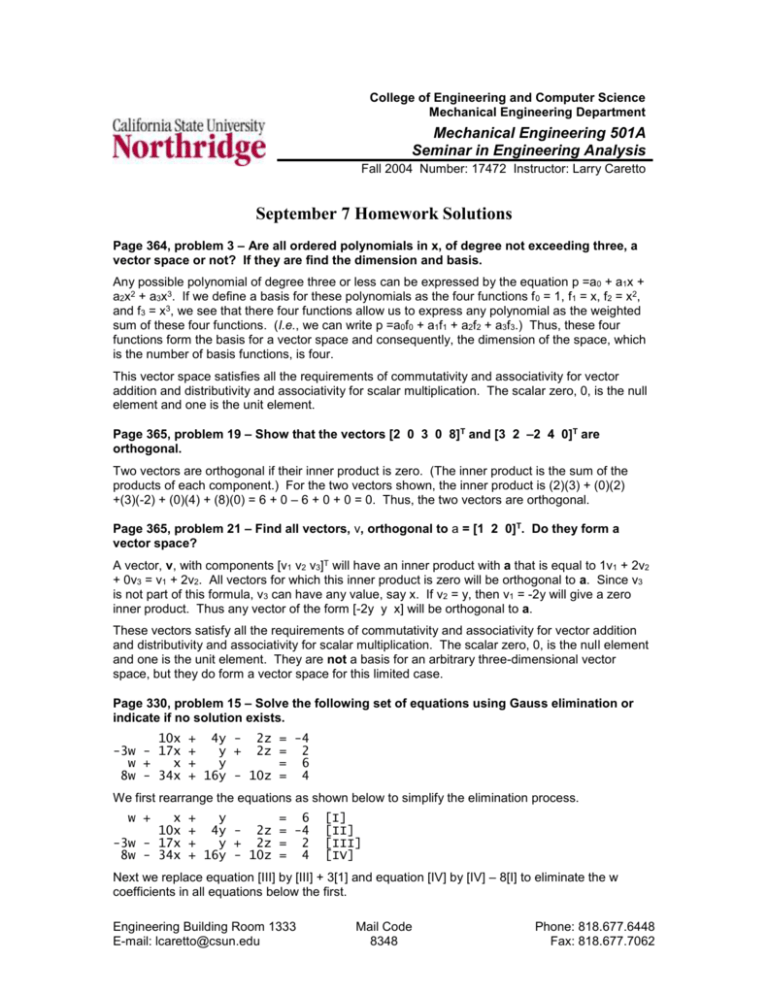
College of Engineering and Computer Science Mechanical Engineering Department Mechanical Engineering 501A Seminar in Engineering Analysis Fall 2004 Number: 17472 Instructor: Larry Caretto September 7 Homework Solutions Page 364, problem 3 – Are all ordered polynomials in x, of degree not exceeding three, a vector space or not? If they are find the dimension and basis. Any possible polynomial of degree three or less can be expressed by the equation p =a0 + a1x + a2x2 + a3x3. If we define a basis for these polynomials as the four functions f 0 = 1, f1 = x, f2 = x2, and f3 = x3, we see that there four functions allow us to express any polynomial as the weighted sum of these four functions. (I.e., we can write p =a0f0 + a1f1 + a2f2 + a3f3.) Thus, these four functions form the basis for a vector space and consequently, the dimension of the space, which is the number of basis functions, is four. This vector space satisfies all the requirements of commutativity and associativity for vector addition and distributivity and associativity for scalar multiplication. The scalar zero, 0, is the null element and one is the unit element. Page 365, problem 19 – Show that the vectors [2 0 3 0 8]T and [3 2 –2 4 0]T are orthogonal. Two vectors are orthogonal if their inner product is zero. (The inner product is the sum of the products of each component.) For the two vectors shown, the inner product is (2)(3) + (0)(2) +(3)(-2) + (0)(4) + (8)(0) = 6 + 0 – 6 + 0 + 0 = 0. Thus, the two vectors are orthogonal. Page 365, problem 21 – Find all vectors, v, orthogonal to a = [1 2 0]T. Do they form a vector space? A vector, v, with components [v1 v2 v3]T will have an inner product with a that is equal to 1v1 + 2v2 + 0v3 = v1 + 2v2. All vectors for which this inner product is zero will be orthogonal to a. Since v3 is not part of this formula, v3 can have any value, say x. If v2 = y, then v1 = -2y will give a zero inner product. Thus any vector of the form [-2y y x] will be orthogonal to a. These vectors satisfy all the requirements of commutativity and associativity for vector addition and distributivity and associativity for scalar multiplication. The scalar zero, 0, is the null element and one is the unit element. They are not a basis for an arbitrary three-dimensional vector space, but they do form a vector space for this limited case. Page 330, problem 15 – Solve the following set of equations using Gauss elimination or indicate if no solution exists. 10x -3w - 17x w + x 8w - 34x + 4y - 2z + y + 2z + y + 16y - 10z = -4 = 2 = 6 = 4 We first rearrange the equations as shown below to simplify the elimination process. w + x 10x -3w - 17x 8w - 34x + y + 4y - 2z + y + 2z + 16y - 10z = 6 = -4 = 2 = 4 [I] [II] [III] [IV] Next we replace equation [III] by [III] + 3[1] and equation [IV] by [IV] – 8[I] to eliminate the w coefficients in all equations below the first. Engineering Building Room 1333 E-mail: lcaretto@csun.edu Mail Code 8348 Phone: 818.677.6448 Fax: 818.677.7062 September 7 homework solutions w + x 10x [-17x +3]x [-34 – 8]x ME501A, L. S. Caretto, Fall 2004 + y + 4y - 2z + [ 1 + 3]y + 2z + [16 – 8]y - 10z = 6 = -4 = [2 + 3(6)] = [4 – 8(6)] Page 2 [I] [II] [III] [IV] Carrying out the indicated multiplications and subtractions gives. W + x 10x -14x -42x + y + 4y - 2z + 4y + 2z + 8y – 10z = 6 = -4 = 20 = -44 [I] [II] [III] [IV] Now we add (14/10) times equation [II] to equation three and (42/10) times equation [II] to equation [IV] to eliminate the x coefficient in the equations [III] and [IV]. (14)(10) (14)( 4) (14)( 2) (14)(6) [ III ] 14 10 x 4 10 y 2 10 z 20 10 (42)(10) (42)( 2) (42)(6) (42)( 4) [ IV ] 42 10 x 8 10 y 10 10 z 44 10 Carrying out the indicated arithmetic in these two equations, the four-equation set becomes W + x + y 10x + 4y 2z + 9.6y – 0.8z + 24.8y – 18.4z = 6 = -4 = 14.4 = -60.8 [I] [II] [III] [IV] Finally we subtract 24.8/9.6 times equation [III] from equation [IV] to complete the upper triangular form. (24.8)(9.6) (24.8)( 0.8) (24.8)(14.4) y 18.4 z 60.8 24.8 9.6 9.6 9.6 [ IV ] The upper triangular form of the equations obtained after completing the indicated arithmetic is shown below. W + x + 10x + + y 4y 2z 9.6y – 0.8z – (49/3)z = 6 = -4 = 14.4 = -98 [I] [II] [III] [IV] We now complete the solution by back substitution. First we solve equation [IV] for z = -98/(-49/3) or z = 6. Next, we use this value of z in equation [III] to solve for y. y 14.4 0.8 z 14.4 0.8(6) 2 9.6 9.6 Now we use y = 2 and z = 6 to solve equation [II] for x. x 4 2 z 4 y 4 2(6) 4(2) 0 10 10 Finally, with x, y, and z known, we can solve equation [1] for w. w 6 y x 620 4 1 1 September 7 homework solutions ME501A, L. S. Caretto, Fall 2004 Page 3 Page 336, problem 5 – Are the vectors [2 –4], [1 9], and [3 5] linearly dependent or independent? Since these are two-dimensional vectors, they must be linearly dependent. (The maximum number of linearly independent vectors equals the dimension of the space.) In this case, it is easy to see that [3 5] = [2 –4] + [1 9]. Page 336, problem 9 – Find the rank of the matrix at the right. We see that this matrix has two columns, which is less than the number of rows (three). Thus, its rank can be at most two, the number of columns. Are the columns linearly independent? 8 4 2 1 6 3 By inspection we can see that the first column is –2 times the second column. Thus, this matrix has only one linearly independent column so its rank is one. Notice that the first row is –4 times the middle row and the last row is –3 times the middle row. Thus, the matrix has only one linearly independent row. We expect this since either the number of linearly independent rows or the number of linearly independent columns determines the rank of a matrix. Both are the same. Page 337, problem 15 – Find the rank of the matrix shown at the right. We see that this matrix has three columns, which is less than the number of rows (four). Thus, its rank can be at most three, the number of columns. Are the columns linearly independent? One approach to determining the rank of the matrix, which equals the number of linearly independent rows, which is the same as the number of linearly independent columns, is to convert the matrix to row-echelon form. To convert the matrix to row echelon form, we use a process similar to Gauss elimination in which we seek to have an increasing number of zeros in each row of the matrix. Since the second row already has a zero in the first column, we can take the first step of getting all coefficients in the first column, in the second row and below, equal to zero as follows. Replace the third row by the sum of the third and first row and replace the fourth row by the sum of the first row minus three times the fourth row. 3 0 3 1 1 4 5 8 4 4 2 4 4 3 1 0 5 8 0 5 8 0 5 8 When we do this, we get the result at the right above, which is seen to have only two linearly independent rows. Hence the rank of the matrix is two. (See the next problem for additional information about this matrix.) Page 337, problem 29 – Find the basis for the row space and the column space for the matrix in problem 15, immediately above. Since the rank of the matrix is two, any two linearly independent rows form a basis for the row space. We see that the two rows [3 1 4] and [0 5 8] are linearly independent (because they are not multiples of each other) and can form one possible basis. Similarly, any two columns can form the basis for the column space of a rank two matrix. Here we can pick the first two columns (again since they are not multiples of each other) as one possible basis. Hence the basis we choose for the column space is [3 0 -3 1]T and [1 5 4 2]T. Note that the answers given on page A17 of Kreyszig have the same row basis as shown here. However, the basis for the column space is taken as the first column divided by three and the last column divided by four. September 7 homework solutions ME501A, L. S. Caretto, Fall 2004 Page 4 Page 350, problem 19 – Solve the system of equations shown below by Cramer’s rule and check by Gauss elimination. The original set of equations, sin 3x + 7y + 8z = -13 2x + 9z = -5 the center, is rearranged as -4x + y – 26z = 2 shown on the right. If we subtract 7 times the first equation from the third equation and use the result to replace the third equation, we have the following result for our set of three equations Finally, subtracting 31/2 times the second equation from the third equation, and replacing the third equation with the result gives the system of equations shown at the right. y - 4x – 26z = 2 [I] 2x + 9z = -5 [II] 7y + 3x + 8z = -13 [III] y - 4x – 26z = 2 [I] 2x + 9z = -5 [II] 31x + 190z = -27 [III] y - 4x – 26z = 2 [I] 2x + 9z = -5 [II] 50.5z = 50.5 [III] We now find the results by back-substitution. First we see that z = 50.5/50.5 or z = 1. We use this value of z to solve for x. x 5 9 z 5 9(1) 7 2 2 Finally we use x = -7 and z = 1 to find y from equation [I]. y 2 26 z 4 x 2 26(1) 4(7) 0 1 1 The solution using Cramer’s rule for three simultaneous equations is given by equation (6) on page 343, which is a special case of the general formula in equations (12) and (13) on page 347. If the general equation is written as ai1x1 + ai2x2 + ai3x3 = bi, i = 1, …, 3, the solution is x1 b1 a12 a13 a11 b1 a13 a11 a12 b1 b2 a 22 a 23 a 21 b2 a 23 a 21 a 22 b2 b3 a32 a33 a31 b3 a33 a31 a32 b3 a11 a12 a13 a11 a12 a13 a11 a12 a13 a 21 a 22 a 23 a 21 a 22 a 23 a 21 a 22 a 23 a31 a32 a33 a31 a32 a33 a31 a32 a33 x2 x3 The determinant in the denominator is the same for all unknowns. For this system of equations (with x1 = x, x2 = y, and x3 = z), we can evaluate the denominator as follows. a11 a12 a13 3 7 8 a23 2 0 9 a33 4 1 26 a21 a22 a31 a32 (3)(0)( 26) (2)(1)(8) (4)(7)(9) (4)(0)(8) (2)(7)( 26) (3)(1)(9) 0 16 252 0 364 27 101 With this determinant for the denominator, we can then find the values of x 1, x2, and x3, as follows. x1 b1 b2 b3 a12 a 22 a32 101 a13 a 23 a33 13 7 8 5 0 9 2 1 26 101 (13)(0)( 26) (5)(1)(8) (2)(7)(9) (2)(0)(8) (5)(7)( 26) (13)(1)(9) 101 0 40 126 0 910 117 101 7 September 7 homework solutions x2 a11 b1 a 21 b2 a31 b3 x3 a13 a 23 a33 101 a11 a12 a13 a12 a 22 a32 101 b1 b2 b3 3 13 8 2 5 9 4 2 26 101 3 7 13 2 0 5 4 1 2 101 ME501A, L. S. Caretto, Fall 2004 (3)( 5)( 26) (2)( 2)(8) (4)( 13)(9) (4)( 5)(8) (2)( 13)( 26) (3)( 2)(9) (3)(0)( 2) (2)(1)( 13) (4)(7)( 5) (4)(0)( 13) (2)(7)( 2) (3)(1)( 5) 101 101 Page 5 390 32 468 160 676 54 0 26 140 0 28 15 101 Thus, Carmer’s rule and Gauss elimination give the same results in this example. 101 0 1
